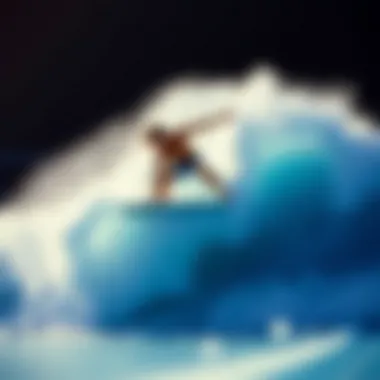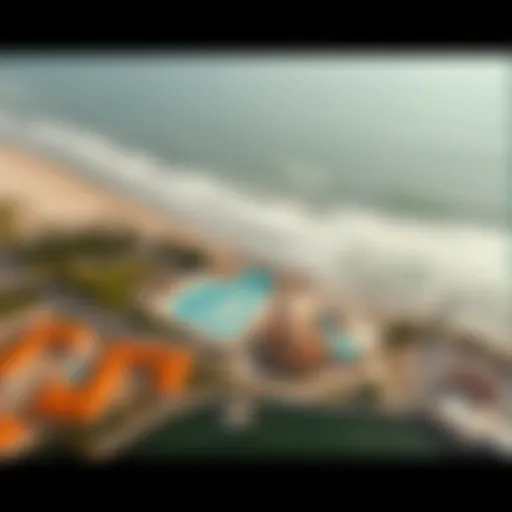Flowrider San Diego: Explore the Culture of Artificial Surfing


Intro
The world of surfing has long been revered for its natural artistry, a marriage between human skill and the rhythmic dance of ocean waves. Yet, as technology strides boldly into various corners of life, the intersection of surf culture and artificial waves emerges as a captivating subject. In this exploration, we’ll dive into Flowrider San Diego, a venue that embodies this fusion by providing a unique opportunity for enthusiasts and novices alike to engage with indoor surfing.
From the technical workings of the Flowrider machine to the cultural implications of practicing in a controlled environment, our examination offers diverse insights tailored for both die-hard surfing fans and those merely curious about this innovative phenomenon. In addition to technical aspects, this piece delves into the surfing lifestyle, examining sustainable practices and how global surf cultures are adapting to the modern world. Through this journey, we intend to illuminate the broader dialogues surrounding artificial surfing, its environmental impacts, and its acceptance in the community.
Surfing Techniques
Mastering the Basics
Whether you’re stepping onto the Flowrider for the first time or a seasoned surfer testing new waters, mastering the basics is crucial. The key to riding the Flowrider lies in understanding the mechanics of the machine, which creates a constant sheet of water flowing down a slope, allowing surfers to practice their balance and technique without the unpredictable nature of ocean waves.
- Stance: Position your feet shoulder-width apart, with your knees slightly bent. This initial posture is the foundation of a solid ride.
- Balance: Unlike traditional surfing, where you ride a wave, the Flowrider requires you to maintain your center of gravity on a steady stream of water, which can feel different at first.
- Grip and Steering: Hold onto the front of the board while using your arms for balance. Steer by leaning your body in one direction or another, maintaining a fluid motion to ride the wave effectively.
Advanced Maneuvers
Once you're comfortable with the basics, the Flowrider opens doors to more advanced moves that can elevate your experience.
- Carving Turns: By shifting your weight from heel to toe and bending your knees, you can initiate sharp turns.
- Spins and Tricks: Incorporate spinning movements for style and flair—such as kick turns or 360-degree spins—while always keeping an eye on balance and positioning.
- Aerial Maneuvers: For those looking for a true thrill, experimenting with getting airborne off the lip of the wave can be a game-changer, albeit requiring confidence and skill.
Surfing Lifestyle
Sustainable Surfing Practices
As the conversation shifts to sustainability, the surfing community is developing practices that align closely with environmental consciousness. The Flowrider experience, for instance, offers an eco-friendly alternative to traditional surfing by minimizing water usage and fostering a space where surfers can practice without harming marine ecosystems. Going green in surf culture may also involve:
- Utilizing eco-conscious surfboards made of sustainable materials.
- Participating in beach clean-ups and community awareness events.
- Supporting brands that prioritize environmental stewardship.
Surf Culture Around the World
Surfing is more than a sport; it's a global culture interwoven in communities from California to Australia and beyond. Different regions boast their styles, traditions, and techniques, reflective of local environments and communities. Here’s how some regions celebrate surf culture:
- Hawaii: Often seen as the birthplace of modern surfing, Hawaii is rich in tradition, deeply connected to native culture, and features iconic surf spots like Waimea Bay.
- Australia: With its vast coastline, surfing is ingrained in Australian lifestyle, famously championed by organizations such as Surf Life Saving Australia, which promotes safety.
- California: Known as the surf capital of the US, California offers a blend of innovation and tradition, hosting countless surf competitions and festivals that celebrate the sport.
"Surfing is not just about riding waves; it's a way of life that connects people to nature and each other."
Exploring these various cultures reveals the multifaceted essence of surfing—an art form sustained by a passion for the ocean and a commitment to its preservation. As we proceed in this article, we will dissect how Flowrider not only caters to the surfing community but becomes a vital thread in the fabric of these diverse surfing lifestyles.
Preface to Flowrider
The rise of artificial surfing has been a game changer in the world of water sports, with the Flowrider at the forefront of this revolution. Located in San Diego, the Flowrider not only introduces a unique surfing experience but also bounces light on the broader culture surrounding surfing. It combines technology with wave riding, and understanding the Flowrider means diving into this convergence of tradition and innovation.
Concept of Artificial Surfing
Artificial surfing, often seen as the future of wave riding, involves using man-made mechanisms to create simulated waves. The Flowrider is a prime example of this concept. It employs a thin sheet of water flowing over a surface that emulates the experience of natural waves. Surfers can ride on this continuous flow, making it accessible regardless of ocean conditions. Prices and space in oceans can vary day-to-day, but with a Flowrider, consistency reigns supreme.
For many, it acts as a training ground where surfers can hone their skills without the unpredictability of weather. Unlike traditional surfing, where the ocean dictates the ride, artificial surfing puts the surfer in the driver’s seat.
"With Flowrider's even waves, it’s like having a reliable friend that never lets you down on a surf day."
This idea resonates particularly in crowded urban settings, where access to the beach might be limited or seasonal. Engaging with the Flowrider opens doors to enthusiasts of all ages, presenting not just an entertaining activity but a lifestyle choice that encourages more people to embrace surfing as a regular pastime.
Significance in Surf Culture
Artificial surfing, particularly through the Flowrider, holds a unique space within surf culture. It's more than just an amusement; it bridges gaps between experienced surfers and beginners. Many surfers view Flowrider as training wheels, a way to tweak their techniques while minimizing the risks associated with ocean surfing.
For locales like San Diego, the Flowrider can serve as a meeting point—where avid surfers and intrigued novices alike gather to share stories, tips, and camaraderie. This sense of community is crucial in fostering a robust surf culture.
Moreover, events organized around the Flowrider, ranging from friendly competitions to skill showcases, help illuminate the sport. These gatherings provide surfers a platform to test their mettle among peers, often breeding collaborations and friendships that extend beyond the artificial waves.
In a time of climate uncertainties and diminishing natural resources, the Flowrider symbolizes resilience within surf culture. As urbanization increases and natural surf spots become busier or more restricted, artificial surfing continues to provide a space for the passion of riding waves, ensuring that the spirit of surfing can thrive well into the future.
In summary, the Flowrider represents not only a thrilling alternative to traditional surfing but also a means of evolving and preserving surf culture. It encapsulates the fun and challenge of surfing while safeguarding its communal essence in the face of changing times.
History of the Flowrider
The Flowrider represents not just a mere conveyance of sport but a cultural phenomenon that speaks volumes about innovation, entertainment, and the complexities of modern surfing culture. Understanding the history of the Flowrider reveals the backbone of its development and how it transformed the way people engage with surfing—both in terms of leisure and competitive sports.
This section will walk you through its origins and development, and how it gained momentum across the United States, establishing itself as a staple attraction in various venues and recreational centers.


Origins and Development
The inception of the Flowrider can be traced back to the early 1990s, when the notion of mechanized wave simulation started gaining traction. The goal was straightforward: create a safe, controlled environment where surfers could practice their skills year-round, regardless of geographic location or prevailing weather conditions. This idea came to fruition with the keen engineering prowess of companies like Wave House and Flow Technologies, which birthed the initial prototypes for artificial surfing.
The basic principle behind the Flowrider is relatively simple yet ingenious. It combines a continuous sheet of flowing water with a gentle slope, mimicking the experience of riding a breaking wave. What began as a handful of test installations quickly burgeoned into a sought-after attraction in surf-centric markets, aided by growing enthusiasm for surfing-related activities. Broader acceptance of surf culture in mainstream media helped, too.
In the mind of enthusiasts, the Flowrider wasn’t just another machine; it also became a canvas for creativity, enabling both seasoned riders and novices to experiment with their styles, from classic longboard moves to more acrobatic tricks.
Milestones to Note:
- 1991: The first commercial Flowrider unit was installed at the Wave House in San Diego.
- 1998: The Flowrider technology expanded into amusement parks and resorts, attracting wider audiences.
- 2005: An uptick in design improvements made the experience more accessible and enjoyable, paving the way for competitive events.
The adoption of the Flowrider has influenced how surfing is perceived and practiced. It challenges the elitism often associated with traditional surfing, drawing in a much-appreciated inclusive crowd.
Growth across the United States
Once the Flowrider concept took root, it spread like wildfire across the country. By the late 2000s, it became a much-adored feature at water parks, cruise ships, and fitness centers—from California to Florida and beyond. This rapid proliferation can be attributed to various factors:
- Accessibility: Unlike ocean surf spots, Flowriders provide an easily accessible way for individuals to engage with the sport.
- Safety Considerations: With a controlled environment, especially for beginners, the risks associated with traditional surfing diminish significantly.
- Cultural Integration: As surfing has continued to grow in popularity, the Flowrider has married its own culture with traditional surf lifestyle, encouraging skateboarding and snowboarding enthusiasts to join in.
Today, there are over 200 Flowrider installations globally, with a hearty concentration across major U.S. cities. This availability has allowed surfers of all skill levels, including those who’ve never set foot on a surfboard, to engage in what is known as a faux surfing experience.
As popular as the Flowrider is, it’s also essential to acknowledge the importance of its growth beyond just a recreational activity; it has become a major social hub and venue for various competitions, endorsements, and community events. The Flowrider has transformed the way enthusiasts observe and participate in surf culture.
The Flowrider serves as a bridge, merging traditional surfing spirit with technological progress.
Overall, the history of the Flowrider has reshaped how both newcomers and seasoned surfers alike perceive the sport, offering a fusion of fun, skill-building, and community engagement in an ever-evolving landscape.
Flowrider San Diego Overview
The emergence of Flowrider San Diego is no ordinary tale. It represents not just the intersection of surf culture and technology but also how the modern surfer experiences their passion. This overview will delve into what sets Flowrider San Diego apart, shining a light on its significance within the broader surfing community.
Location and Accessibility
Flowrider San Diego sits nestled on the sun-kissed shores of California, making it easily accessible to both locals and visitors alike. Located at the vibrant Belmont Park, it stands as a beacon to thrill-seekers and families alike. The park itself is well-connected by public transport, making it simple for anyone from tourists wandering the boardwalk to serious surfers looking to hone their skills in a controlled environment. Parking is plentiful, but it can fill up quick during weekends, so arriving early might save the frustration of hunting for a spot.
Moreover, the Flowrider is open year-round, offering an almost continuous opportunity for surfers to catch a wave, regardless of the season or weather. Whether you’re a seasoned surfer or a novice, the welcoming atmosphere encourages everyone to give it a go. Accessibility isn’t just physical; the diverse range of skill levels catered to means that groups of friends or family members can enjoy the ride together, with tailored lessons available for beginners.
Facility Features
Stepping inside the Flowrider complex, the excitement palpable in the air is hard to ignore. The facility boasts state-of-the-art features designed to maximize the experience.
- Wave Generation System: The heart of Flowrider is its cutting-edge wave generation technology. This system creates a continuous sheet of water, simulating authentic wave motion, which can vary in intensity. This means that surfers can practice their skills, whether it's mastering basic balance or working on tricks.
- Surf and Bodyboard Options: Not limited to surfing, the Flowrider accommodates both boarders and surfers, allowing for a versatile surfing experience. Riders can choose between flowboarding and traditional surfing stances, providing a larger array of experiences.
- Dedicated Training Zones: For those serious about improving their surfing skills, dedicated training areas are available. They are equipped with video monitoring so surfers can review their techniques and progress, which can contribute to faster learning and enhancement of skills.
- Safety Features: Understanding the need for safety while enjoying such activities, Flowrider San Diego has various safety measures in place, from padded walls to trained instructors guiding participants about the dos and don’ts. This makes it an inviting and secure environment for all ages.
- Amenities: Beyond the surfing experience, the facility includes areas for rest and refreshment. Guests can grab a bite to eat or simply relax by the poolside. There are also viewing areas for those who prefer to watch the action unfold, adding to the camaraderie of the surfing culture.
Investing in such facilities speaks volumes about the commitment to both experience and community. Flowrider San Diego is not merely a venue; it's a pulsating hub of surf culture, where waves meet camaraderie in the city’s stunning backdrop.
The Flowrider not only taps into the thrill of surfing but also fosters a culture where people can build lasting connections. It symbolizes the evolution of surfing, blending technology with tradition, ensuring that anyone can experience the thrill of riding the waves—all without ever leaving the shore.
Mechanics of the Flowrider
Understanding the mechanics behind the Flowrider is essential to appreciating its role in the world of artificial surfing. It’s not just about having fun on a board, but delving into the technology that makes it all possible. The Flowrider operates on principles of fluid dynamics and engineering, creating a consistent and safe surf-like experience. This section explores the specifics of wave generation technology and the overall workings of the machine.
Wave Generation Technology
The technology that lies at the heart of the Flowrider is quite remarkable. At its core, it uses a special pump system to circulate water, producing an artificial wave. Here’s how it typically works:
- Water Supply: The system pulls water from a designated reservoir.
- Pump Mechanism: High-powered pumps propel the water upward, creating a sheet that flows down a slope.
- Shape and Surface: The incline and surface play crucial roles in maintaining the wave shape, allowing riders to catch and ride the wave, mimicking real surfing conditions.
This setup allows the machine to generate waves that can reach speeds necessary for surfing. The beauty lies in its ability to regulate both wave height and speed, catering to different skill levels. Riders can experience a gentle rolling wave or a more challenging high-speed one—tailoring to their preference.
The implications here are profound for surf enthusiasts. Not only do they experience the thrill of surfing in a controlled environment, but advances in wave technology might also inspire more sustainable and accessible surfing experiences. An interesting aspect here is that it allows surfers to practice their technique year-round, independent of natural waves.
How the Flowrider Works
Let’s take a closer look at how the Flowrider functions from a rider’s perspective. When a person steps onto the Flowrider:
- Gearing Up: Riders are typically provided with a surfboard or bodyboard, along with safety gear. This gear helps ensure that they stay safe while they ride.
- Starting Position: After getting comfortable, they position themselves at the edge, facing downstream.
- Activation: The machine is activated, and water rushes along the surface. This begins the creation of the wave.
- Balance and Technique: Riders must balance on their boards while maneuvering with their body weight to maintain stability.
- Wave Riding: Once balance is achieved, they can carve, spin, or ride the wave, mimicking traditional surfing techniques. The continuous flow of water keeps the wave consistent, allowing for longer rides.
This intricate interaction between technology and rider sets the stage for what many describe as an exhilarating experience. It not only serves the purpose of entertainment but also offers a unique community space for surfers—both seasoned and novice.


"The Flowrider brings the ocean to you, providing the perfect blend of challenge and fun, regardless of where you’re from."
Experience at Flowrider San Diego
The Flowrider offers a unique space for both budding and seasoned surfers to navigate the intricacies of surfing without the unpredictability of the ocean's waves. Within this artificial surfing paradise, it's not just about riding a wave; it's about mastering a skill set that bridges the gap between surfing and indoor entertainment.
Surfing Techniques Adaptation
To excel on the Flowrider, surfers must adjust their techniques to accommodate the peculiar dynamics of the machine's wave-producing capabilities. Unlike traditional surfing, where riding an irregular wave is the name of the game, the Flowrider throws consistent and manageable waves at the rider, allowing for a steady learning curve.
Surfers must adapt in various ways:
- Posture Adjustments: On the Flowrider, a low center of gravity is crucial for balance. Riders lean forward slightly, lowering their knees and engaging their core to maintain control.
- Foot Positioning: Unlike ocean waves, where foot placement can alter with the unpredictability of the water, the Flowrider demands precise positioning at all times. Surfers learn to shift their weight effectively to maintain balance when riding.
- Paddleback Techniques: Riders not only need to learn how to take off properly but also to "paddle back" to avoid slipping off the surf surface, a technique that is not as prevalent in traditional surfing.
“The Flowrider teaches adaptability; it’s about finding your sweet spot on the board before tackling a wave.”
For those who traditionally surf, this adjustment period might seem daunting, yet it's often a welcome challenge that emphasizes skill development in a controlled environment. Adaptation here leads to more refined skills on actual surf trips, making it a worthwhile endeavor.
Skill Levels Supported
The beauty of the Flowrider lies in its inclusivity, supporting a diverse range of skill levels from novices just dipping their toes into the surfing world to experienced surfers looking to hone their craft. This broad capacity is largely what makes it a favored destination.
- Beginners: For the uninitiated, Flowrider provides an opportunity to conquer the fear of falling, offering a soft landing and a chance to practice without the harshness of ocean waves. Lessons are often offered that focus on fundamental techniques, allowing beginners to build confidence quickly.
- Intermediate Surfers: Those with some experience can polish their turns, tricks, and transitions. The machine's consistent waves grant surfers the chance to repeatedly practice their maneuvers until they become second nature, something harder to achieve in natural surfing conditions.
- Advanced Surfers: For seasoned pros, the Flowrider serves as a creative outlet for refining tricks and exploring new styles without the unpredictability of the ocean. Many skilled surfers use this controlled environment to innovate their approaches and work on complex moves.
By accommodating various skill levels, Flowrider San Diego fosters a welcoming atmosphere that resonates with a wide array of surf lovers.
In Summary
Overall, the experience at Flowrider San Diego is not merely about learning how to surf; it's about growing within a community and challenging one’s limits in a safe yet exhilarating space. The combination of adaptable techniques and the supportive environment enables a rich experience that can be quite rewarding.
Community and Culture
The essence of any recreational activity often lies in the community that forms around it, and surfing, particularly in a place like Flowrider San Diego, is no exception. The mingling of people drawn together by their love for waves—real or artificial—creates a vibrant culture that is as integral to the experience as the act of riding itself. Let’s delve into how Flowrider San Diego fosters a unique environment promoting personal connections, skill-sharing, and a deeper appreciation for surfing.
Building a Surf Community
When you step into Flowrider San Diego, you’re not just entering a venue for artificial surfing; you’re stepping into a thriving community. This place has become a haven for surfers—both seasoned and novices—where one can easily strike up a conversation with a fellow boarder about techniques, local lore, or the complexities of wave riding. The venue encourages camaraderie, as people often bond over shared wipeouts or victories when they manage to stay upright just a split second longer.
- Shared Learning Experience: Unlike open ocean surfing, where the seas may be intimidating for beginners, Flowrider presents an environment tailored for learning. New surfers can gain confidence with each ride, often guided by more experienced surfers who offer tips and encouragement. It’s not uncommon to hear someone shout, "You got this!" when a newbie takes their first ride.
- Regular Meet-Ups: Flowrider San Diego hosts casual meet-ups where surfers can come together, exchange stories, and simply enjoy the thrill of riding artificial waves. These gatherings foster a sense of belonging and help in creating lasting friendships through shared passions as they navigate the water side by side.
Building this community isn’t just about the thrill of surfing; it’s the shared stories and laughter that make it all worthwhile. Many regulars find themselves forming a tight-knit group, holding each other accountable in their quest to improve and challenge one another, making their surfing journey even richer.
Events and Competitions
Surf competitions at Flowrider San Diego are not just contests; they serve as a celebration of the community spirit and skills that have flourished within the venue. These events bring together diverse groups who share the excitement of friendly rivalry and mutual respect.
- Local Competitions: Events often include local surfers showing their prowess. By showcasing unique talents—from stylish tricks to impressive maneuvers—the community thrives on the competitive spirit while strengthening bonds amongst participants. Each competition feels akin to a gathering of old friends rather than a cutthroat contest.
- Workshops and Training Sessions: Flowrider San Diego often connects with top surfers to conduct workshops during weekends. These sessions cover everything from basic paddling techniques to advanced tricks, allowing enthusiasts to elevate their skills and learn from the best in a supportive environment; such events often introduce newcomers to seasoned professionals in a welcoming manner.
"Competitions are not just about who rides the best; they're about lifting each other up as we all try to catch that perfect wave."
Through these events, Flowrider San Diego stands as a testament to cultural diversity, blending various surfing styles and backgrounds into a single community. This unity adds depth to the surfing experience, showing how a shared passion can elevate a recreational activity into a culture that values growth and connection across generations.
Overall, the community and culture surrounding Flowrider San Diego highlight the transformative power of surf culture. It’s about more than just riding waves; it’s about creating connections, sharing experiences, and building lasting friendships in and out of the water.
The bond forged here not only enhances individual surfing experiences but also enriches the broader surfing culture as a whole. Those seeking to understand Flowrider’s impact would do well to appreciate this aspect, as it embodies the spirit of surf enthusiasts who carry the mantra of community with them, beam and all.
Comparative Analysis with Traditional Surfing
The juxtaposition between artificial surfing at Flowrider San Diego and traditional surfing presents a fascinating dialogue about adaptation, innovation, and cultural intersection. Being two sides of the same coin, this section delves into how they compare across various elements, providing essential insights for surf lovers and enthusiasts.
Benefits and Limitations
Artificial surfing offers unique advantages that attract a diverse crowd. Here are some key benefits that Flowrider San Diego presents:
- Accessibility: Flowrider allows experiences regardless of ocean conditions. Rain or shine, wind or calm, surf enthusiasts can ride the waves without waiting for the perfect swell. A novice surfer can hit the boards without the anxiety of ocean riptides.
- Controlled Environment: Riders enjoy the ability to practice in a safe setting. Here, injuries are less frequent, and the risk factors associated with natural surfing are reduced significantly. Beginners learn to maneuver and balance more effectively before they venture into unpredictable waters.
- Year-round Operation: Unlike traditional surf spots, often limited by seasons and weather, Flowrider provides an opportunity for surfing virtually all year, which could be appealing for those itching to catch a wave anytime.
However, these benefits do not come without their limitations:
- Realism of Experience: The experience on a Flowrider, while exhilarating, does not completely replicate the conditions of a natural wave. The feel of the ocean and the spontaneity of its waves are component factors that artificial systems lack.
- Cultural Disconnect: Traditional surfing is deeply rooted in local cultures and communities. The ocean isn't just a sport; it's a part of heritage and lifestyle. Flowrider lacks this cultural depth and history, making it more of an entertainment venue than a spiritual journey.
- Sustainability Concerns: While some elements of Flowrider technology are designed with conservation in mind, the long-term environmental impact of such facilities remains debated. Traditional surfing, on the other hand, encourages a connection to the ocean that fosters environmental stewardship.


Cultural Perspectives
In the broader examination of cultural perspectives, the differences between Flowrider and traditional surfing illuminate significant aspects:
- Community and Belonging: Surfing is often described as a way of life, creating a bond between individuals and their oceanic surroundings. Traditional surfers tend to form strong communities that share knowledge, traditions, and stories passed down through generations. In contrast, artificial surfing venues like Flowrider may prioritize profit or entertainment over fostering grassroots culture.
- Sportsmanship and Competition: Flowrider events may focus more on showcasing technical skills without the environmental and social factors that influence traditional surf competitions. In events like the World Surf League, competitors face not only the task of riding but also the unpredictable nature of surf conditions, creating a narrative of not just skill but resilience and adaptability.
- Cultural Integration: Indigenous communities have rich legacies tied to surfing, from Hawaiian traditions to Australian customs. In artificial environments, these elements can often feel diluted or absent, as the experience becomes commercialized.
The ongoing dialogue between traditional and artificial surfing will likely shape the future of how enthusiasts engage with the sport. While Flowrider offers convenience and accessibility, it also challenges the true essence of what surfing embodies historically and culturally.
In exploring such dynamics, one finds that both methods of surfing can coexist, each contributing uniquely to humanity's enduring relationship with the waves.
For further insights on the topic and its interrelation in surf culture, you can explore relevant resources like Wikipedia or articles from Britannica that delve into the nuances of surfing's evolution.
Environmental Considerations
The environmental implications of Flowrider operations can’t be brushed aside. As these machines mimic the thrilling experience of surfing, they bring along notable concerns on resource use and sustainability. This section will explore critical aspects like water usage and conservation efforts implicated in the functionality of Flowrider, as well as broader sustainability practices that can be applied to artificial surfing environments.
Water Usage and Conservation
Water is the lifeblood of any surfing experience, and the Flowrider is no different. The flow of water, while important for creating those perfect waves, raises several issues regarding conservation.
- Volume of Water Used: Each session on a Flowrider can use a significant amount of water - often thousands of gallons to maintain the wave feature. Hence, it is essential to consider how this water is sourced and reused.
- Water Recycling Systems: Fortunately, many Flowrider venues, including the one in San Diego, are investing in advanced water recycling systems. These systems filter and reuse water, drastically reducing the overall consumption.
- Local Water Resources: With California’s ongoing droughts, the use of water for recreational purposes is hotly debated. It’s critical that Flowrider installations align with local water conservation incentives and practices, to ensure that water extraction does not put stress on the supply.
As surfing culture grows, awareness around water conservation has to grow hand in hand. Flowrider must engage with the community to champion responsible water use, educating patrons on conservation and strategies to enjoy the waves while caring for the environment.
Sustainability in Artificial Surfing
Sustainability stretches beyond just water use. Looking at the lifecycle of a Flowrider, one can identify several avenues for enhancing eco-friendliness:
- Energy Utilization: Flowriders require electricity to power their equipment. Incorporating renewable energy sources, like solar panels, can significantly reduce their carbon footprint. Some establishments are beginning to look into energy-efficient motor systems, which can lead to lower overall energy consumption.
- Material Choices: The construction of Flowrider machines often uses various materials, some of which can be more environmentally hazardous than others. Opting for sustainable materials during manufacturing can positively impact the overall environmental footprint.
- Community Engagement: Hosting events that raise awareness of ecological topics can foster an appreciation for the environment among surfers. Building a culture around not just the sport, but also environmental responsibility can create lasting changes in behaviors.
The best surfing experience is one that respects both the ocean and the technology that attempts to replicate it.
Visiting a Flowrider can be an exciting thrill, but it’s crucial that these venues operate with an eye on the environment. The balance between enjoying artificial waves and preserving natural resources is delicate. With conscious effort toward sustainability, Flowrider San Diego can serve as a beacon for both surfing enthusiasts and environmentalists, merging passion with responsibility.
Economic Impact of Flowrider
The role of Flowrider in the economic landscape of San Diego cannot be understated. As a hub for both locals and tourists, it serves not just as an entertainment venue but as a significant player in the local economy. The appeal of artificial surfing attracts diverse crowds, which in turn stimulates various sectors including hospitality, retail, and services. The blend of technology and recreation observed at Flowrider is reshaping the economic dynamics of the area, making it a focal point for surfing enthusiasts and casual visitors alike.
Tourism and Local Economy
Flowrider San Diego is a magnet for tourists, drawing surfers and thrill-seekers from all over. The influx of visitors leads to heightened activity in the surrounding area. Hotels, restaurants, and shops benefit from the presence of enthusiastic visitors eager to explore San Diego’s vibrant offerings.
- Increased Foot Traffic:
Many tourists, while visiting Flowrider, also explore nearby attractions such as the beach or local parks, boosting foot traffic in those areas. - Spending on Services:
Visitors often indulge in nearby dining and shopping options, increasing the overall spending within the local economy. - Extended Stay Potential:
Those who come specifically for Flowrider may choose to extend their stay to enjoy other San Diego attractions, further enhancing economic input from their visit.
In essence, Flowrider acts as a gateway for tourism, where its draw creates a ripple effect, benefiting many businesses and promoting local prosperity.
Job Creation and Opportunities
The operations at Flowrider also contribute significantly to job creation, providing employment opportunities that cater to a diverse range of skill sets.
- Direct Employment:
Positions at the facility itself, such as instructors and maintenance staff, help in sustaining local job markets. The demand for skilled instructors, for instance, has led many passionate surfers to find rewarding jobs. - Support Industries:
Beyond direct jobs at Flowrider, various support industries such as catering, event planning, and merchandise sales witness growth alongside its success. - Entrepreneurial Opportunities:
As Flowrider continues to attract crowds, entrepreneurial prospects arise, from surf gear rentals to surf schools, enriching the local economy and fostering a spirit of innovation.
"Economic growth is a wave that can lift many boats, and Flowrider exemplifies this trend within the surf culture fabric of San Diego."
All in all, Flowrider more than just entertains; it incubates opportunities and resources that bolster the economic strength of its community. It may seem like just a wave machine, but its impact on the economy is as deep as the ocean.
Future of Flowrider San Diego
The future of Flowrider San Diego is a compelling topic that intertwines the evolving dynamics of artificial surfing with broader environmental and economic considerations. As technology continues to advance and the demand for alternative surf experiences grows, the significance of Flowrider becomes increasingly pronounced within both the surfing community and the local economy. This segment delves into projected trends, the anticipated impact of innovations, and potential hurdles that may shape the course of this unique surfing venue.
Technological Innovations
Innovation is the heartbeat of progress, and the Flowrider stands to gain from the continual evolution of technology in wave simulation. The artificial surfing machines are likely to undergo significant enhancements, making waves more realistic than ever. For instance, improvements in wave generation methods could enable more customizable flow conditions, tailoring experiences for seasoned surfers and novices alike. This adaptability would cater to a wider range of skill levels, allowing more participants to engage successfully with the sport.
In addition, integration with virtual reality could become commonplace. Swimmers could wear VR headsets, immersing themselves in exotic surf spots without leaving the comfort of San Diego. This blend of tech not only makes the experience more engaging but also ignites a fresh narrative in surf culture—one that blurs the lines between reality and simulation.
Moreover, equipped with smart sensors, the machines could provide real-time feedback on user performance, giving critical insights on how to improve technique. This results-driven approach to surfing can attract athletes globe-wide who are focused on honing their craft, subsequently elevating the venue's status as a training hub.
Potential Challenges
With every opportunity comes its own challenges. While the advancements in technology are promising, there are several issues Flowrider must contend with as it looks to the future. First and foremost, the financial aspect cannot be overlooked. Implementing cutting-edge technologies may require substantial investment. If the costs to run such a facility escalate, this could ultimately drive up the prices for users, potentially alienating casual surfers.
Another concern is maintaining the environmental balance, especially as discussions about sustainability in surfing circles grow louder. The installation of advanced machines, while innovative, must not contradict the sustainable practices that organizations in the surfing community are striving for. This includes responsible water use and conservation of resources, which are crucial for garnering community support.
Additionally, as technology alters the surfing landscape, purists might push back against these changes. They could argue that artificial surfing dilutes the essence of the sport, leading to a clash between tradition and innovation that needs careful navigation.
In summary, the future of Flowrider San Diego is poised at a crossroads where technology, community, and culture intersect. To thrive, it must embrace advancements while also addressing economic and environmental challenges head-on. The journey ahead will likely be as exhilarating as the rides on its very own artificial waves.















